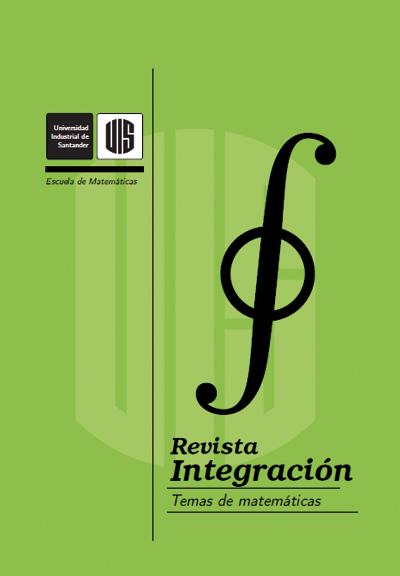Artículos científicos
Publicado 1999-04-15
Cómo citar
Sabogal, S. M. (1999). Sobre autosemejanza topológica, Parte I. Revista Integración, Temas De matemáticas, 17(1), 27–47. Recuperado a partir de https://revistas.uis.edu.co/index.php/revistaintegracion/article/view/877
Resumen
Un espacio topológico X se dice autosemejante (topológicamente) si todo abierto no vacío contiene un subespacio homeomorfo a X. Se presentan ejemplos (entre ellos \beta N-N), propiedades e interrelación con conceptos afines como autosemejanza simbólica y atractor de un sistema iterado de funciones.
Palabras claves. Autosimilitud, espacios autohomeomorfos, cocientes del espacio de Cantor, fractales.
Descargas
Los datos de descargas todavía no están disponibles.
Referencias
[1]F.G.Arenas y M.A. Sánchez, “S1is a self–similar symbolic space”,TopologyAtlas Preprint, No.283, URL:http://at.yorku.ca /p/a/a/m/06.htm.
[2]C. Bandt and K. Keller, “Self–Similar Sets 2. A Simple Approach to theTopological Structure of Fractals”,Math. Nachr.,154(1991), 27–39.
[3]M. Barnsley,Fractals Everywhere, Academic Press, Inc., San Diego, 1988.
[4]M. Barnsley y S. Demko, “Iterated function systems and the global construc-tion of fractals”,Proc. Roy. Soc. London, Ser.A 399( 1985), 243–275.
[5]W. J. Charatonik y A. Dilks, “On self–homeomorphic spaces”,Topol. andits Appl.,55(1994), 215–238.
[6]K. J. Falconer,The Geometry of Fractal Sets, Cambridge University Press,Cambridge, Gran Bretaña, 1985.
[7]M. García, J. Margalef, C. Olano de L. y E. Outerelo,Topología∗,Editorial Alhambra, S. A., 1975.[8]M. Hata, “On the Structure of Self–Similar Sets”,Japan J. Appl. Math.,2(1985), 381–414.
[9]J. E. Hutchinson, “Fractals and Self–similarity”,Indiana Univ. Math. J.,30(1981), 713–747.
[10]R. F. Isaacs, “Las Palabras en el espacio de Cantor”,Memorias del PrimerCongreso Nacional de Neurocomputación, Santa fé de Bogotá, Junio de 1995,65–79.
[11]A. Kameyama, “Self–similar Sets from the Topological Point of View”,JapanJ. Indust. Appl. Math.,10(1993), 85–95.
[12]A. Kameyama, “Julia sets and self–similar sets”,Topology and its Applications,54(1993), 241–251.
[13]N. Levine, “Semi–open sets and semi–continuity in Topological Spaces”,Amer.Math. Month.,70(1963), 36–41.
[14]G. B. Lewellen, “Self–Similarity”,Rocky Mountain Journal of Mathematics,23(1993), 1023–1040.
[15]B. Mandelbrot,Los Objetos Fractales. Forma, hazar y dimensión, Tusquets Editores, S.A., Barcelona, Espa ̃na, 1993.
[16]G. Sarton,Historia de la Ciencia (La ciencia antigua durante la edad de orogriega), Editorial Universitaria de Buenos Aires, Buenos Aires, 1965.
[17]F. Takeo, “Self–Similar Sets and Quotient Sets of Infinite Sequences”,NationalScience Report, Ochanomizu University 43, No. 2(1992), 61–74.
[18]R. C. Walker,The Stone– ̆Cech compactification, Addison–Wesley PublishingCompany, 1970 [19]S. Willard,General Topology, Addison–Wesley Publishing Company, 1970.
[2]C. Bandt and K. Keller, “Self–Similar Sets 2. A Simple Approach to theTopological Structure of Fractals”,Math. Nachr.,154(1991), 27–39.
[3]M. Barnsley,Fractals Everywhere, Academic Press, Inc., San Diego, 1988.
[4]M. Barnsley y S. Demko, “Iterated function systems and the global construc-tion of fractals”,Proc. Roy. Soc. London, Ser.A 399( 1985), 243–275.
[5]W. J. Charatonik y A. Dilks, “On self–homeomorphic spaces”,Topol. andits Appl.,55(1994), 215–238.
[6]K. J. Falconer,The Geometry of Fractal Sets, Cambridge University Press,Cambridge, Gran Bretaña, 1985.
[7]M. García, J. Margalef, C. Olano de L. y E. Outerelo,Topología∗,Editorial Alhambra, S. A., 1975.[8]M. Hata, “On the Structure of Self–Similar Sets”,Japan J. Appl. Math.,2(1985), 381–414.
[9]J. E. Hutchinson, “Fractals and Self–similarity”,Indiana Univ. Math. J.,30(1981), 713–747.
[10]R. F. Isaacs, “Las Palabras en el espacio de Cantor”,Memorias del PrimerCongreso Nacional de Neurocomputación, Santa fé de Bogotá, Junio de 1995,65–79.
[11]A. Kameyama, “Self–similar Sets from the Topological Point of View”,JapanJ. Indust. Appl. Math.,10(1993), 85–95.
[12]A. Kameyama, “Julia sets and self–similar sets”,Topology and its Applications,54(1993), 241–251.
[13]N. Levine, “Semi–open sets and semi–continuity in Topological Spaces”,Amer.Math. Month.,70(1963), 36–41.
[14]G. B. Lewellen, “Self–Similarity”,Rocky Mountain Journal of Mathematics,23(1993), 1023–1040.
[15]B. Mandelbrot,Los Objetos Fractales. Forma, hazar y dimensión, Tusquets Editores, S.A., Barcelona, Espa ̃na, 1993.
[16]G. Sarton,Historia de la Ciencia (La ciencia antigua durante la edad de orogriega), Editorial Universitaria de Buenos Aires, Buenos Aires, 1965.
[17]F. Takeo, “Self–Similar Sets and Quotient Sets of Infinite Sequences”,NationalScience Report, Ochanomizu University 43, No. 2(1992), 61–74.
[18]R. C. Walker,The Stone– ̆Cech compactification, Addison–Wesley PublishingCompany, 1970 [19]S. Willard,General Topology, Addison–Wesley Publishing Company, 1970.
